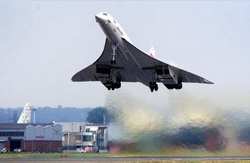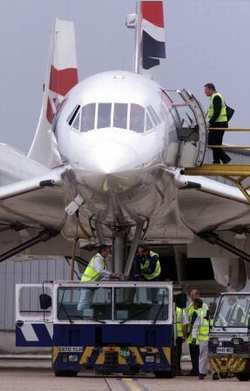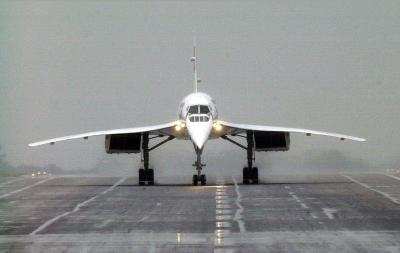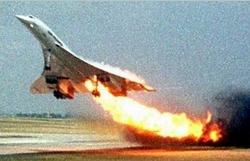Air France Retires Concorde
By ANN Associate Editor Pete Combs
 I remember the first time I saw it. Actually, I
heard it before I saw it - the loudest jet roar I'd ever heard in
my 13 years of life. It was an Air France Concorde flying into
Washington's Dulles Airport. I stood and watched its needle-like
figure cross the sky like a stately spaceship, an out-of-this world
design that promised Washington-London flights in four hours.
Racing the sun. I kept thinking about racing the rotation of the
Earth... and winning.
I remember the first time I saw it. Actually, I
heard it before I saw it - the loudest jet roar I'd ever heard in
my 13 years of life. It was an Air France Concorde flying into
Washington's Dulles Airport. I stood and watched its needle-like
figure cross the sky like a stately spaceship, an out-of-this world
design that promised Washington-London flights in four hours.
Racing the sun. I kept thinking about racing the rotation of the
Earth... and winning.
In the days just after the Concordes began to fly, I remember
the controversy that surrounded them. They were loud. There were
sonic booms. I remember the terrifying sound of sonic booms from an
earlier day in my childhood, near Tinker AFB (OK). But this, the
Concorde, seemed so graceful, so full of promise, a dream of modern
travel in ultimate style and comfort.
Friday, the dream ended for Air France. Soon, British Airways,
the only other airline to fly the Concorde, will also retire the
supersonic jetliners.
Air France's Last Concorde Run
 Friday, hundreds of people stood around the fence
at New York's JFK Airport to watch Air France bring to a close 34
years of supersonic passenger flight. The Concorde flew to Charles
DeGaulle Airport in Paris in just three hours. The 79 passengers,
some with tears in their eyes, deplaned the Concorde, one saying
(with perhaps typical French fatalism), "In France we don't know
how to hold on to what is beautiful."
Friday, hundreds of people stood around the fence
at New York's JFK Airport to watch Air France bring to a close 34
years of supersonic passenger flight. The Concorde flew to Charles
DeGaulle Airport in Paris in just three hours. The 79 passengers,
some with tears in their eyes, deplaned the Concorde, one saying
(with perhaps typical French fatalism), "In France we don't know
how to hold on to what is beautiful."
"Concorde will never really stop flying because it will live on
in people's imagination," Air France Chairman Jean-Cyril Spinetta
told Reuters.
"It's the end of an era in aviation," Dominique Bussereau,
France's transport secretary, told the Associated Press. The last
Air France Concorde flight originated at JFK, as fire trucks
sprayed a rainbow of colored water to send the supersonic aircraft
off in style.
Those who were on board were fully appreciative of the
standard-setting Mach 2 service. Christophe Mazel, the chief
financial officer of Michelin Tires in Thailand, said of the jet:
"You're eating the most beautiful food, drinking the most beautiful
wine. You can't compare it even to first class."
"I kept my eyes wide open during the whole flight" to look out
the window, said passenger Vincent Olivetto, adding, "It's an
unforgettable memory." Olivetto unashamedly admits having shed a
few tears upon landing in Paris.
Air France said in a statement Wednesday, "For Air France,
Concorde belongs to humanity's aviation heritage and it must
therefore be possible to see and admire it." Both Air France and
British Airways are intent on dedicating the Concorde fleet to
museums around the world.
"This will be true of the entire Air France Concorde fleet. all
planes that belong to it will be presented to the public." Sir
Richard Branson, the flambouyant CEO of Virgin-Atlantic Airlines,
is reportedly crushed by news that the Concorde won't fly again.
Branson was recently snubbed by both BA and Air France in his bid
to purchase the entire Concorde fleet for his own airline,
Virgin-Atlantic.
"We think it's a tragedy," a spokesman for Virgin told the AFP
news agency. "The minimum would be to keep them in flight and
preserve them for historic reasons."

But French expert aviation expert Pierre Condom was skeptical
about Mr Branson's aspirations. "It's a bluff, it's a total fraud,"
he told French television. "First of all, there are no spare parts
- the series was stopped a long time ago. The know-how only exists
in two companies: Air France and British Airways.... It's
impossible."
The Beginning Of A Dream
The joint French-British project to create a supersonic
passenger service began as a dream in the late 1950s. By 1962, they
came up with a design and in 1969, The first pilot, Andre Turcat,
said on his return to the airport: "Finally the big bird flies, and
I can say now that it flies pretty well." The flight took only 27
minutes and was dubbed completely successful.
Final Resting Place
The British city of Bristol wants to display a Concorde when BA
retires its fleet of the supersonic passenger jets later this year.
Other cities and museums are fighting tooth-and-nail for a display
model.
 Bitter times recently have led to the economic
inviability of the Concorde - even before the September 11, 2001
terror attacks on New York and Washington. Passenger loads started
dropping in 2000, when an Air France Concorde crashed shortly after
take-off, killing 113 people. Since that fatal crash, there have
been several relatively minor technical problems on Concordes that
led engineers to worry whether the nearly three-decades-old icon of
flight was near the end of its useful life:
Bitter times recently have led to the economic
inviability of the Concorde - even before the September 11, 2001
terror attacks on New York and Washington. Passenger loads started
dropping in 2000, when an Air France Concorde crashed shortly after
take-off, killing 113 people. Since that fatal crash, there have
been several relatively minor technical problems on Concordes that
led engineers to worry whether the nearly three-decades-old icon of
flight was near the end of its useful life:
November 27, 2002: Part of the tail assembly
breaks away from a Concorde en route from London to New York.
November 6, 2002: The cockpit crew aboard an
Air France Concorde had to shut down one of the engines after
noticing a fault light on the control panel.
November, 2002: A BA Concorde flying from
London to New York was forced to turn back because of a warning
indicator in the cockpit.
October 30, 2002: A New York-London BA Concorde
had to cut its speed to below Mach 1 after the crew got reports of
window cracks that threatened to decompress the passenger
cabin.
July, 2002: Turnaround after engine power
surge
April, 2002: Engine failure causes mid-air
'bang' which sounded to passengers like a car backfiring.
March, 2002: Take-off abandoned after computer
glitch
Nov, 2001: Flight aborted when instruments show
engine overheats
But for guys like me who were ten years old or so when they
first saw the pristine white needle streak across the sky, first
heard the tremendously powerful engines roar, it will be the end of
an era in aviation, the end of a dream and the realization that,
with every passing day, many such dreams fade into dim, if not
cherished, memories.
 ANN's Daily Aero-Term (12.19.25): Ultrahigh Frequency (UHF)
ANN's Daily Aero-Term (12.19.25): Ultrahigh Frequency (UHF) NTSB Prelim: Cirrus Design Corp SR22T
NTSB Prelim: Cirrus Design Corp SR22T Classic Aero-TV: The Red Tail Project--Carrying the Torch of the Tuskegee Airmen
Classic Aero-TV: The Red Tail Project--Carrying the Torch of the Tuskegee Airmen Aero-News: Quote of the Day (12.19.25)
Aero-News: Quote of the Day (12.19.25) Airborne 12.17.25: Skydiver Hooks Tail, Cooper Rotax Mount, NTSB v NDAA
Airborne 12.17.25: Skydiver Hooks Tail, Cooper Rotax Mount, NTSB v NDAA






